 Last additions - Uji 宇治市 Last additions - Uji 宇治市 |

In the end, we could even eat the used tea leaves which tasted like spinach maybe.Jul 20, 2017
|
|

Another cup.Jul 20, 2017
|
|

First cup of tea.Jul 20, 2017
|
|

Our tea-making kit. Jul 20, 2017
|
|

Our instructor (on the left).Jul 20, 2017
|
|

Hot water thermos.Jul 20, 2017
|
|

Our tea-making kit. Everything is provided.Jul 20, 2017
|
|

Inside Takumi no Yakata. Like a workshop or classroom for making tea.Jul 20, 2017
|
|
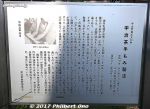
Jul 20, 2017
|
|

Takumi no Yakata was where we could make our own tea (with careful instructions).Jul 20, 2017
|
|

Entrance to Takumi no Yakata (匠の館).Jul 20, 2017
|
|

Tourists visiting Byodo-in temple can also experience and taste Uji tea at nearby Takumi no Yakata (匠の館).Jul 20, 2017
|
|

Small grinder.Jul 20, 2017
|
|

Grinder faceJul 20, 2017
|
|

Sample grinder. The dried tea leaves are fed through a funnel to the grinding stones.Jul 20, 2017
|
|

Matcha tea leaves to be ground.Jul 20, 2017
|
|

Stone grinders grinding matcha tea leaves into fine matcha power at Horii Shichimeien's tea factory. Watching these grinders was mesmerizing..Jul 20, 2017
|
|

Stone grinders grinding matcha (tencha) tea leaves into fine matcha power at Horii Shichimeien's tea factory.Jul 20, 2017
|
|

It was a room full of stone grinders grinding matcha tea leaves into fine matcha power.Jul 20, 2017
|
|

Inside Horii Shichimeien's tea factory.Jul 20, 2017
|
|

We then got to see Horii Shichimeien's matcha tea factory. (Note that this is not open to normal tourists.)Jul 20, 2017
|
|

Mrs. Horii prepares a different kind of tea.Jul 20, 2017
|
|

Jul 20, 2017
|
|
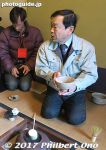
Jul 20, 2017
|
|

Matcha tea and a confection. The tea was outstanding. It had a malty, matcha taste. Pretty thick. The aftertaste was interesting.Jul 20, 2017
|
|

Behind Horii Shichimeien's tea shop is a small tea house for tea ceremony. Mr. Horii kindly prepares his finest marcha tea for us.Jul 20, 2017
|
|

Some of the finest Uji matcha powder at Horii Shichimeien.Jul 20, 2017
|
|

Some of the finest Uji matcha powder at Horii Shichimeien.Jul 20, 2017
|
|

Jul 20, 2017
|
|

Jul 20, 2017
|
|

Near their tea farm, Horii Shichimeien also has a tea shop selling some of Japan's finest tea.Jul 20, 2017
|
|

Jul 20, 2017
|
|

Only part of the original Okunoyama Chaen remains as a tea field. The original Okunoyama tea field was larger. Notice the shade.Jul 20, 2017
|
|

In 15th century, Ashikaga Yoshimitsu and Yoshinaga loved Uji tea so much that they designated seven tea fields as the Seven Reknown Tea Fields. Today only Okunoyama Chaen remains.Jul 20, 2017
|
|

Chotaro Horii is the 6th-generation owner/operator of Horii Shichimeien which was originally Okunoyama Chaen (奥ノ山茶園), one of Uji's Seven Reknown Tea Fields (七名園).Jul 20, 2017
|
|

Pine treeJul 17, 2017
|
|

Very unusual thatched roof home near Manpukuji.Jul 17, 2017
|
|

Fire hydrant manhole. Near Manpukuji, Uji, Kyoto.Jul 17, 2017
|
|

"Curios" is an archaic term from the Meiji Period.Jul 17, 2017
|
|
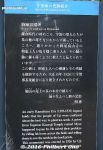
About Koma no Ashikage-en Monument. According to legend, local people in Uji pondered over how to sow the seeds to grow tea.It was then Priest Myoe (明恵), from the Kegon-shu Buddhist Sect, came on horseback and trotted on the field saying, "Plant the seeds in my horse's hoof prints." This monument was built by Uji tea growers in 1926 to express their appreciation to Myoe.Jul 17, 2017
|
|

Koma no Ashikage-en Monument in front of the entrance to Manpukuji temple. This can be roughly translated as "Hoof Print Field Monument." 駒蹄影園跡碑This monument is part of the Japan Heritage designation for Uji tea history.Jul 17, 2017
|
|

Marijuana leaf (or maybe maple leaf) design on this street gutter cover near Manpukuji. Probably hemp leaves, commonly used for making cloth.Jul 17, 2017
|
|
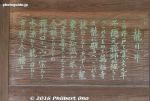
Jul 17, 2017
|
|

WellJul 17, 2017
|
|

Buddhist picture print too.Jul 17, 2017
|
|

Sample printings.Jul 17, 2017
|
|

Woodblock for printing Buddhist scripture. Looks very worn out.Jul 17, 2017
|
|

Jul 17, 2017
|
|

Jul 17, 2017
|
|

Tetsugen Doko (1630-1682), one of Ingen's Japanese disciples, started the project to make these printing blocks still used today.Jul 17, 2017
|
|

Manpukuji also has a subtemple and treasure house called Hozoin (宝蔵院) noted for storing tens of thousands of woodblocks that are still used for printing Buddhist scriptures.Jul 17, 2017
|
|

Entrance to Hozoin.Jul 17, 2017
|
|

Jul 17, 2017
|
|

Jul 17, 2017
|
|

Jul 17, 2017
|
|

Jul 17, 2017
|
|

Manpukuji also has a subtemple and treasure house called Hozoin (宝蔵院) noted for storing tens of thousands of woodblocks used for printing Buddhist scriptures.Jul 17, 2017
|
|

Lotus in a pot at Manpukuji temple.Jul 17, 2017
|
|

Little pine cones at Manpukuji.Jul 17, 2017
|
|

Dessert. One of the best meals I ever had in Japan. Advance reservations are required. It's not a walk-in restaurant. More info photos in Japanese: https://www.obakusan.or.jp/eat/Jul 17, 2017
|
|

Rice was finally served at the end with pickles.Jul 17, 2017
|
|

Jul 17, 2017
|
|

Jul 17, 2017
|
|

Fucha ryori has no fish nor meat.Jul 17, 2017
|
|

Fucha ryori became very popular after it was first introduced in Japan. No wonder. It looks exotic and tastes absolutely delicious. Salad.Jul 17, 2017
|
|

Appetizers of our full-course, Chinese-style religious vegetarian cuisine at Icho-an. This plate was for four people. Very different, very colorful, and such a unique taste and deliciousness that I've never had before.Fucha ryori is healthy too. Well worth the ¥5,000 which I first thought was quite pricey for a religious meal with no meat. Got stuffed and we could take home some food too.Jul 17, 2017
|
|

Inside Icho-an. We could immediately tell that it was Chinese since the food was served on a turntable (Lazy Susan) which you can see in the photo.(This photo was taken after we finished lunch.)Jul 17, 2017
|
|

Icho-an restaurant serves Chinese-style shojin-ryori (religious vegetarian cuisine) called fucha-ryori (普茶料理). This is another thing about Manpukuji. The sect's founder Ingen helped to spread Chinese cuisine in Japan from the 17th c.Jul 17, 2017
|
|

Near the Sanmon Gate is this entrance to Icho-an restaurant. 銀杏庵Jul 17, 2017
|
|

A simple bento (box lunch) fucha ryori at Manpukuji temple, Uji, Kyoto 普茶料理Jul 17, 2017
|
|

"Obaku-san Fucha Ryori" bento-type (box lunch) fucha ryori for our large tour group. It costs around ¥3,000.Jul 17, 2017
|
|

On my second visit to Manpukuji, I went with a group of foreigners and had lunch at the temple's restaurant Oryokaku (黄龍閣) serving Chinese-style shojin-ryori (religious vegetarian cuisine) called fucha-ryori (普茶料理).Jul 17, 2017
|
|

Plum blossoms.Jul 17, 2017
|
|

Women cleaning the sliding lattice doors before repapering.Jul 17, 2017
|
|

Prayer tablets (ema)Jul 17, 2017
|
|

About the Bell TowerJul 17, 2017
|
|

Bell tower (Important Cultural Property)Jul 17, 2017
|
|

伽藍堂Jul 17, 2017
|
|

伽藍堂 (Important Cultural Property)Jul 17, 2017
|
|

Jul 17, 2017
|
|

Manpukuji's famous wooden fish board used like a gong to indicate the time. 魚梆Jul 17, 2017
|
|

Manpukuji's famous fish board. 魚梆Jul 17, 2017
|
|

Jul 17, 2017
|
|

About Hatto Hall. Jul 17, 2017
|
|

Hatto Hall's bell-shaped window.Jul 17, 2017
|
|

Jul 17, 2017
|
|

Behind the Daiohoden Hall is Hatto Hall (Important Cultural Property) where Buddhist lectures are held. 法堂(はっとう)Jul 17, 2017
|
|

Rear view of Daiohoden Hall.Jul 17, 2017
|
|

Rear view of Daiohoden Hall.Jul 17, 2017
|
|

Jul 17, 2017
|
|

Jul 17, 2017
|
|

Jul 17, 2017
|
|

Jul 17, 2017
|
|

Jul 17, 2017
|
|

Jul 17, 2017
|
|

Each arhat has a name.Jul 17, 2017
|
|

Daiohoden Hall also has statues of the Eighteen Arhats. 十八羅漢像They are the original followers of the Buddha who have reached the state of Nirvana and are free of worldly desires. Jul 17, 2017
|
|

These mats on the floor are not for sitting. The priests stand behind the mats and chant.Jul 17, 2017
|
|

Side view of the Shaka Nyorai.Jul 17, 2017
|
|

Chinese wooden fish drum for beating during prayers.Jul 17, 2017
|
|

Jul 17, 2017
|
|

Shaka Nyorai or Gautama Buddha, founder of Buddhism. 釈迦如来座像Jul 17, 2017
|
|

Jul 17, 2017
|
|

Altar inside Daiohoden Hall, Manpukuji's main temple. It worships a sitting Shaka Nyorai or Gautama Buddha. 大雄寶殿(だうおうほうでん)Jul 17, 2017
|
|

In front of Daiohoden Hall.Jul 17, 2017
|
|

Daiohoden Hall entrance.Jul 17, 2017
|
|

Round window at Daiohoden Hall.Jul 17, 2017
|
|

Chinese-style incense burner.Jul 17, 2017
|
|

Daiohoden Hall (Important Cultural Property), Manpukuji's main temple. 大雄寶殿(だうおうほうでん)Jul 17, 2017
|
|

About Daiohoden Hall.Jul 17, 2017
|
|

Daiohoden Hall (Important Cultural Property), Manpukuji's main worship hall or temple. 大雄寶殿(だうおうほうでん)Jul 17, 2017
|
|

Jul 17, 2017
|
|

Daiohoden Hall roof.Jul 17, 2017
|
|

Jul 17, 2017
|
|

Corridor to Daiohoden Hall.Jul 17, 2017
|
|

Jul 17, 2017
|
|

Jul 17, 2017
|
|

Jul 17, 2017
|
|

Jul 17, 2017
|
|

Jul 17, 2017
|
|

Jul 17, 2017
|
|

Jul 17, 2017
|
|

Jul 17, 2017
|
|

Jul 17, 2017
|
|

Jul 17, 2017
|
|

Jul 17, 2017
|
|

Statue behind the Hotei statue.Jul 17, 2017
|
|

Our Manpukuji priest guide spoke through our interpreter.Jul 17, 2017
|
|
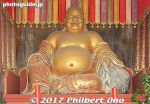
Inside Manpukuji's Tennoden Hall is Hotei, one of the Seven Gods of Good Fortune. 天王殿(てんのうでん)、弥勒菩薩(布袋)Jul 17, 2017
|
|

Our Manpukuji priest guide admits his resemblance to Hotei and kindly posed next to it.Jul 17, 2017
|
|

Inside the Tennoden Hall is Hotei, one of the Seven Gods of Good Fortune. 天王殿(てんのうでん)、弥勒菩薩(布袋)Jul 17, 2017
|
|

Jul 17, 2017
|
|

Tennoden Hall (Important Cultural Property). 天王殿(てんのうでん)Jul 17, 2017
|
|

Jul 17, 2017
|
|

Manpukuji temple bell in a corridor.Jul 17, 2017
|
|

Manpukuji temple bell in a corridor.Jul 17, 2017
|
|

Manpukuji corridor lanterns.Jul 17, 2017
|
|

Jul 17, 2017
|
|

石碑Jul 17, 2017
|
|

寿塔Jul 17, 2017
|
|

Manpukuji has a lot of covered corridors linking the major buildings.Jul 17, 2017
|
|

The big Sanmon Gate in the background.Jul 17, 2017
|
|

Kaizan-do HallJul 17, 2017
|
|

Altar inside the Kaizan-do Hall.Jul 17, 2017
|
|

Jul 17, 2017
|
|

Chinese design on the railing. Temple buildings are in Ming-style. Many buildings are Important Cultural Properties, but no National Treasures. 卍崩しのデザインJul 17, 2017
|
|

Chinese-style architecture is obvious with the roof corners curling upward.Jul 17, 2017
|
|

Manpukuji's Kaizan-do Hall (Important Cultural Property) where sect founder Yinyuan Longqi (Ingen) is worshipped. 開山堂(かいさんどう)Jul 17, 2017
|
|

Very fine roof.Jul 17, 2017
|
|

Karahafu roof gableJul 17, 2017
|
|

Karahafu roof gableJul 17, 2017
|
|

Jul 17, 2017
|
|

Before going to Tennoden Hall, we turned left to this small gate leading to Kaizan-do Hall.Jul 17, 2017
|
|

Jul 17, 2017
|
|

From Sanmon Gate, path to Tennoden Hall. The path is modeled after dragon scales.Jul 17, 2017
|
|

From Sanmon Gate, path to Tennoden Hall. The path is modeled after dragon scales.Jul 17, 2017
|
|

From Sanmon Gate, path to Tennoden Hall. The path is modeled after dragon scales.Jul 17, 2017
|
|

The Sanmon main gate (exit side). 三門(さんもん)Jul 17, 2017
|
|

At the Sanmon Gate, pay the admission to enter the temple. It's a very interesting temple, but they don't really have English explanations.Jul 17, 2017
|
|

Sanmon main gate. 三門(さんもん)Jul 17, 2017
|
|

The Sanmon main gate (Important Cultural Property). 三門(さんもん)Jul 17, 2017
|
|

Jul 17, 2017
|
|

Lotus pond in front of Sanmon Gate. 放生池Jul 17, 2017
|
|

Manpukuji (萬福寺) is a large temple complex and headquarters of a Chinese Zen sect (Obaku-shu). It's one of the Big Three Zen sects in Japan (besides Soto and Rinzai).The founder was Chinese Zen master Yinyuan Longqi (Ingen) from Fujien Province in China who came to Japan via Nagasaki in 1654. Manpukuji (or Mampukuji) is part of the Japan Heritage for Uji tea history. A short walk from Obaku Station on the JR Nara Line and Keihan Uji Line. Jul 17, 2017
|
|

Chinese-style Somon Gate (Important Cultural Property), the first entrance to Manpukuji. It's a quite a large temple complex with numerous buildings. A few of the major buildings are open to the public. 総門(そうもん)Jul 17, 2017
|
|
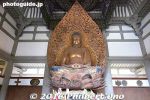
Since photography inside the central hall is not allowed, here's a photo of the replica at Valley of the Temples in Hawaii. It is very similar. One thing missing are the celestial Buddhas decorating the white walls behind the Buddha.Jul 17, 2017
|
|
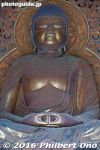
Sitting Amida Buddha replica at Valley of the Temples in Hawaii. It is very similar to the real one at Byodo-in.Jul 17, 2017
|
|

Uji River is near Byodo-in.Jul 17, 2017
|
|

A gate being renovated.Jul 17, 2017
|
|

Jul 17, 2017
|
|

Jul 17, 2017
|
|

Jul 17, 2017
|
|

Jul 17, 2017
|
|

Jul 17, 2017
|
|

Jul 17, 2017
|
|

Jul 17, 2017
|
|
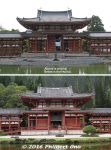
The center structure of both the original and replica houses a statue of a sitting Buddha.The replica in Hawaii has a much more dramatic backdrop with the Koolau mountains. The original Byodo-in has no mountains in the background, and thankfully and miraculously, no tall, modern buildings either.Jul 17, 2017
|
|
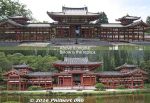
People from Hawaii would know Byodo-in since there's a ferro-concrete replica in a park-like cemetery called Valley of the Temples on the island of Oahu.The replica of the Phoenix Hall was built in 1968 to mark the 100th anniversary of the first Japanese immigrants to Hawaii. I photographed the one in Hawaii last year and now I can compare the two.
As you can see, the replica is very accurate. They say that the one in Hawaii is a smaller scale, but it looks the same as the original (made of wood) in Kyoto. Perhaps only the surrounding garden is smaller. Also, the one in Hawaii seems to house offices on the upper floor. (If you look behind the building, you can see stairs and air conditioners.) The original one's upper floor is see-through with no walls.Jul 17, 2017
|
|

Looks like intricate work and it's gonna look fabulous when it's done.Jul 17, 2017
|
|

Although the major renovations were completed, they were still restoring the paintings on the doors, etc., of Byodo-in.Jul 17, 2017
|
|

Entrance to the see the sitting Amida Buddha. Photography inside the central hall is not allowed.Jul 17, 2017
|
|

Entering the Phoenix Hall.Jul 17, 2017
|
|

The pond as seen from the Phoenix Hall.Jul 17, 2017
|
|

Jul 17, 2017
|
|

The Byodo-in admission ticket does not include admission to the Phoenix Hall's central hall (sitting Amida Buddha).Jul 17, 2017
|
|

Jul 17, 2017
|
|

Entrance to the Byodo-in Phoenix Hall where you can see the sitting Amida Buddha after paying the extra ¥300 admission. Have to buy a ticket to enter at the specified time because only a limited number can fit inside.Jul 17, 2017
|
|

Jul 17, 2017
|
|

The center structure of both the original and replica houses a statue of a sitting Buddha.Jul 17, 2017
|
|

Jul 17, 2017
|
|

Byodoin Museum Hoshokan displays many Buddhist art treasures of the temple. Opened in 2001. You can visit this museum after you see the Phoenix Hall.Jul 17, 2017
|
|

Entrance to Byodo-in. Pay admission fee to enter.Jul 17, 2017
|
|

Map of the Byodo-in temple complex. It's not that big. The Phoenix Hall has a central hall flanked by two L-shaped wings in front of a pond. Jul 17, 2017
|
|
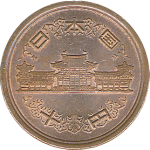
Byodo-in on the back of the ¥10 coin.Jul 17, 2017
|
|

In Uji, Kyoto, Byodo-in is one of Japan's most famous temples and most recognizable buildings.Byodo-in is acuallly a temple complex, but this building, called the Phoenix Hall (Ho'odo 鳳凰堂), is the main attraction and a National Treasure. Jul 17, 2017
|
|

The central hall houses a sitting Amida Buddha with celestial floating Buddhas on the surrounding walls. The Phoenix Hall was originally constructed in 1053 (Heian Period).Jul 17, 2017
|
|
|
|